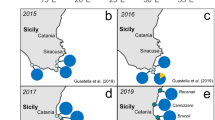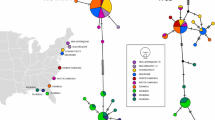Abstract
Invasions mediated by humans have been reported from around the world, and ships’ ballast water has been recognized as the main source of marine invaders worldwide. Some invasions have dramatic economic and ecological consequences. On the other hand, many invasions especially in the marine realm, can go unnoticed. Here we identify a human mediated, worldwide introduction of the hydrozoan species Turritopsis dohrnii. The normal life cycle of hydrozoans involves the asexual budding of medusae from colonial polyps. Medusae of Turritopsis, however, when starved or damaged, are able to revert their life cycle, going back to the polyp stage through a process called transdifferentiation. They can thus easily survive through long journeys in cargo ships and ballast waters. We have identified a clade of the mitochondrial 16S gene in Turritopsis which contains individuals collected from Japan, the Pacific and Atlantic coasts of Panama, Florida, Spain, and Italy differing from each other in only an average of 0.31% of their base-pairs. Fifteen individuals from Japan, Atlantic Panama, Spain, and Italy shared the same haplotype. Turritopsis dohrnii medusae, despite the lack of genetic differences, are morphologically different between the tropical and temperate locations we sampled, attesting to a process of phenotypic response to local conditions that contributes to making this grand scale invasion a silent one.


Similar content being viewed by others
References
Bavestrello G, Sommer C, Sarà M (1992) Bi-directional conversion in Turritopsis nutricula (Hydrozoa). In: J Bouillon F Boero F Cicogna JM Gili and RG Hughes (eds) Aspects of Hydrozoan biology Sci Mar 56:137–140
Boero F, Bouillon J (1993) Zoogeography and life cycle patterns of Mediterranean hydromedusae (Cnidaria). Biol J Linn Soc 48:239–266
Bouillon J, Gravili C, Pagès F et al (2006) An introduction to Hydrozoa. Publ Sci Mus Paris 14:1–591
Brodeur RD, Sugisaki H, Hunt GL (2002) Increases in jellyfish biomass in the Bering Sea: implications for the ecosystem. Mar Ecol Prog Ser 233:89–103. doi:10.3354/meps233089
Carlton JT (1989) Man’s role in changing the face of the ocean: biological invasion and implications for conservation of nearshore environments. Conserv Biol 3:265–273. doi:10.1111/j.1523-1739.1989.tb00086.x
Carlton JT, Geller JB (1993) Ecological roulette: the global transport of nonindigenous marine organisms. Science 261:78–82. doi:10.1126/science.261.5117.78
Cohen AN, Carlton JT (1998) Accelerating invasion rate in a highly invaded estuary. Science 279:555–558. doi:10.1126/science.279.5350.555
Cunningham CW, Buss LW (1993) Molecular evidence for multiple episodes of paedomorphosis in the family Hydractiniidae. Biochem Syst Ecol 21:57–69. doi:10.1016/0305-1978(93)90009-G
Dawson MN, Jacobs DK (2001) Molecular evidence for cryptic species of Aurelia aurita (Cnidaria, Scyphozoa). Biol Bull 200:92–96. doi:10.2307/1543089 Woods Hole
Fukui Y (1995) Seasonal changes in testicular structure of the sea Anemone Haliplanella lineata (Coelenterata: Actiniara). Invertebr Rep Dev 27:197–204
Gould SJ (1977) Ontogeny and phylogeny. The Belknap Press of Harvard University Press, Cambridge MA
Govindarajan AF, Halanych KM, Cunningham CW (2005) Mitochondrial evolution and phylogeography in the hydrozoan Obelia geniculata (Cnidaria). Mar Biol (Berl) 146:213–222. doi:10.1007/s00227-004-1434-3
Grosholz ED, Ruiz MG (1996) Predicting the impact of introduced marine species: lessons from the multiple invasions of the European green crab Carcinus maenas. Biol Conserv 78(1–2):59–66
Grosholz ED, Ruiz GM (2003) Biological invasions drive size increases in marine and estuarine invertebrates. Ecol Lett 6:700–705. doi:10.1046/j.1461-0248.2003.00495.x
Hasegawa M, Kishino K, Yano T (1985) Dating the human-ape splitting by a molecular clock of mitochondrial DNA. J Mol Evol 22:160–174. doi:10.1007/BF02101694
Holland BS (2000) Genetics of marine bioinvasions. Hydrobiologia 420:63–71. doi:10.1023/A:1003929519809
Holland BS, Dawson MN, Crow GL et al (2004) Global phylogeography of Cassiopea (Scyphozoa: Rhizostomeae): molecular evidence for cryptic species and multiple invasions of the Hawaiian Islands. Mar Biol (Berl) 145:1119–1128. doi:10.1007/s00227-004-1409-4
Huey RB, Gilchrist GW, Carlson ML et al (2000) Rapid evolution of a geographic cline in size in an introduced fly. Science 287:308–309. doi:10.1126/science.287.5451.308
Johnston RF, Selander RK (1964) House sparrow: rapid evolution of races in North America. Science 144:548–550. doi:10.1126/science.144.3618.548
Kubota S (2005) Distinction of two morphotypes of Turritopsis nutricula medusae (Cnidaria Hydrozoa Anthomedusae) in Japan with reference to their different abilities to revert to the hydroid stage and their distinct geographical distributions. Biogeography 7:41–50
Kumar S, Tamura K, Nei M (2004) MEGA3: integrated software for Molecular Evolutionary Genetics Analysis and sequence alignment. Brief Bioinform 5:150–163. doi:10.1093/bib/5.2.150
Mackie JA, Kenough MJ, Christinidis L (2006) Invasion pattern inferred from cytochrome oxidase I sequences in three bryozoans Bugula neritina, Watersipora subtorquata and Watersipora arcuata. Mar Biol (Berl) 149:285–295. doi:10.1007/s00227-005-0196-x
Maddison DR, Maddison WP (2000) MacClade version 4: analysis of phylogeny and character evolution. Sinauer Associates, Sunderland Massachusetts
Miglietta MP, Piraino S, Kubota S et al (2007) Species in the genus Turritopsis (Cnidaria Hydrozoa) a molecular evaluation. J Zoolog Syst Evol Res 45:11–19. doi:10.1111/j.1439-0469.2006.00379.x
Mooney HA, Cleland EE (2001) The evolutionary impact of invasive species. Proc Natl Acad Sci USA 98:5446–5451. doi:10.1073/pnas.091093398
Oakley TH, Cunningham CW (2000) Independent contrasts succeed where explicit ancestor reconstructions fail in a known bacteriophage phylogeny. Evolution Int J Org Evolution 54(2):397–405
Pimentel D, Zuniga R, Morrison D (2005) Update on the environmental and economic costs associated with alien-invasive species in the United States. Ecol Econ 52:273–288. doi:10.1016/j.ecolecon.2004.07.013
Piraino S, Boero F, Aeschbach B et al (1996) Reversing the life cycle: medusae transforming into polyps and cell transdifferentiation in Turritopsis nutricula (Cnidaria Hydrozoa). Biol Bull 190:302–312. doi:10.2307/1543022
Piraino S, De Vito D, Schmich J et al (2004) Reverse development in Cnidaria. Can J Zool 82:1748–1754. doi:10.1139/z04-174
Posada D, Crandall KA (1998) Modeltest: testing the model of DNA substitution. Bioinformatics 14:817–818. doi:10.1093/bioinformatics/14.9.817
Savidge JA (1987) Extinction of an island forest avifauna by an introduced snake. Ecology 68:660–668. doi:10.2307/1938471
Sax DF, Stachowicz JJ, Brown JH et al (2007) Ecological and evolutionary insights from species invasions. Trends Ecol Evol 22:465–471. doi:10.1016/j.tree.2007.06.009
Schuchert P (2005) Species boundaries in the hydrozoan genus Coryne. Mol Phylogenet Evol 36:194–199. doi:10.1016/j.ympev.2005.03.021
Schuchert P (2006) The European athecate hydroids and their medusae (Hydrozoa Cnidaria): capitata part 1. Rev Suisse Zool 113:325–410
Swofford DL (2002) PAUP* Phylogenetic Analysis Using Parsimony (*and Other Methods) version 4.0b10. Sinauer Associates, Sunderland Massachusetts
Thompson JD, Gibson TJ, Plewniak F, Jeanmougin F, Higgins DG (1997) The CLUSTAL_X windows interface: flexible strategies for multiple sequence alignment aided by quality analysis tools. Nucleic Acids Res 25:4876–4882. doi:10.1093/nar/25.24.4876
Zabin CJ, Zardus J, Bettini Pitombo F, Fread V, Hadfield MG (2007) A tale of three seas: consistency of natural history traits in a Caribbean-Atlantic barnacle introduced to Hawaii. Biol Invasions 9:523–544. doi:10.1007/s10530-006-9056-y
Zwickl DJ (2006) Genetic algorithm approaches for the phylogenetic analysis of large biological sequence datasets under the maximum likelihood criterion [http://wwwbioutexasedu/faculty/antisense/garli/Garlihtml] PhD dissertation, The University of Texas at Austin
Acknowledgments
We thank the staff of the Smithsonian Marine Stations of Naos, Bocas del Toro, Galeta and Fort Pierce for logistical support. We also thank S. Piraino for sharing information, A. Faucci and M. Rossi for discussion and suggestions on the manuscript, A. Driskell for DNA extraction and sequencing of some of the specimens, and C.S. Dugas for collecting some of the specimens from Bocas del Toro. This work was funded by a Smithsonian Marine Science Network postdoctoral fellowship to M.P.M.
Author information
Authors and Affiliations
Corresponding author
Rights and permissions
About this article
Cite this article
Miglietta, M.P., Lessios, H.A. A silent invasion. Biol Invasions 11, 825–834 (2009). https://doi.org/10.1007/s10530-008-9296-0
Received:
Accepted:
Published:
Issue Date:
DOI: https://doi.org/10.1007/s10530-008-9296-0






